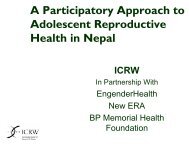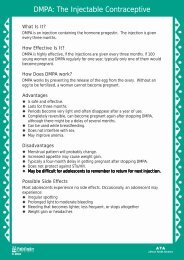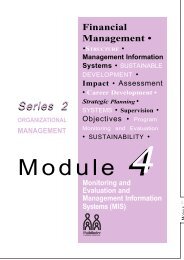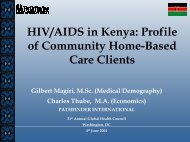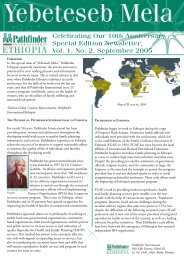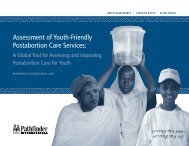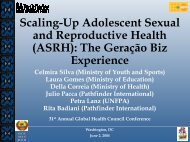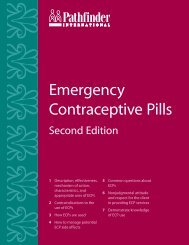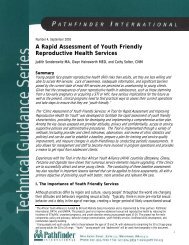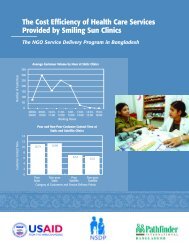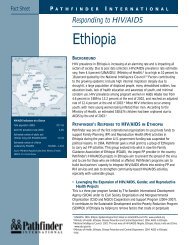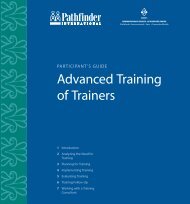reproductive health services for adolescents - Pathfinder International
reproductive health services for adolescents - Pathfinder International
reproductive health services for adolescents - Pathfinder International
Create successful ePaper yourself
Turn your PDF publications into a flip-book with our unique Google optimized e-Paper software.
Module 16/Unit 8<br />
Specific Objective # 1: Describe the impact of STI/HIV on<br />
<strong>adolescents</strong><br />
CONTENT<br />
Knowledge/Attitudes/Skills<br />
WHY ARE YOUTH AT RISK FOR<br />
STIS/HIV<br />
• Adolescent women are biologically<br />
more susceptible than older women<br />
to STIs.<br />
• The young female genital tract is not<br />
mature and is more susceptible to<br />
infection (a biological risk <strong>for</strong> girls).<br />
More cervical epithelial tissue is<br />
exposed at the opening of the vagina<br />
into the cervix and this tissue is more<br />
susceptible.<br />
• Women often do not show symptoms<br />
of chlamydia and gonorrhea, the<br />
most common STIs, and having<br />
another STI increases their<br />
susceptibility to HIV. Adolescent<br />
women become infected with<br />
HIV/AIDS at twice the rate of<br />
adolescent men.<br />
• Sexual violence and exploitation, lack<br />
of <strong>for</strong>mal education (including<br />
sexuality education), inability to<br />
negotiate with partners about sexual<br />
decisions, and lack of access to<br />
<strong>reproductive</strong> <strong>health</strong> <strong>services</strong> work<br />
together to put young women at<br />
especially high risk.<br />
• Both adolescent boys and girls may<br />
have immune systems that have not<br />
previously been challenged and have<br />
not mobilized defenses against<br />
sexually transmitted infections.<br />
• Sexual intercourse is often unplanned<br />
and spontaneous.<br />
Training/Learning Methods<br />
(Time Required)<br />
TRAINER PRESENTATION (5 MIN.)<br />
The trainer should explain that<br />
<strong>adolescents</strong> often think that they are too<br />
young or inexperienced to get an STI.<br />
They think that they are not at risk<br />
because they believe that "only<br />
promiscuous or bad people get STIs." As<br />
a provider, you play an important role in<br />
teaching <strong>adolescents</strong> about how to<br />
prevent STIs as well as providing<br />
treatment <strong>for</strong> those who contract a STI.<br />
LEARNING EXERCISE: YOUTH AT<br />
RISK COMPETITION (20 MIN.)<br />
The trainer should:<br />
• Divide Px into 2 groups.<br />
• Ask each group to come up with as<br />
many biological and social reasons<br />
as they can that put youth at risk <strong>for</strong><br />
STIs and record them on newsprint.<br />
One group should list risks <strong>for</strong><br />
adolescent boys and one <strong>for</strong><br />
adolescent girls.<br />
• Allow 10 minutes <strong>for</strong> groups to<br />
discuss.<br />
• Reconvene the large group.<br />
• Ask each group to present their lists.<br />
The group with the most reasons gets<br />
a prize.<br />
• Discuss the lists and supplement with<br />
in<strong>for</strong>mation from the content.<br />
<strong>Pathfinder</strong> <strong>International</strong><br />
104<br />
Adolescent Curriculum



